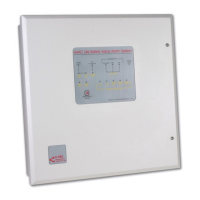A
VAC VOICE ALARM SYSTEM
AVAC Installation and Maintenance Manual • Approved Document No. DAU0000402 Rev 6 • Page 27
1
.1 Power Supply / Mains Faults
A power supply/mains fault is indicative of one or more of the following faults.
T
he mains supply is too low or has failed completely.
Symptoms: AVAC runs on batteries, but not on mains. The red ‘Hazardous Voltages Present’
light on the Power Supply PCB may be lit (if Mains has failed the LED will be off) .
Suggested action:
(a) Isolate the mains supply and probe the live and neutral connections with a multimeter.
(b) Taking all due precautions, re-apply the mains and measure the voltage.
(c) Isolate the mains supply again.
If the reading is incorrect (see Technical Specifications at the back of this manual) repair the
mains supply. If the reading is correct, check to see if the primary mains fuse (F1) is ruptured.
If the fuse is intact and the red hazardous voltages present light on the Power Supply PCB is
lit, then the PSU is faulty and should be replaced.
The primary mains fuse (F1) is ruptured.
Symptoms: AVAC runs on batteries, but not on mains. The red ‘Hazardous Voltages Present’
light on the Power Supply PCB is off.
Suggested action:
(a) Isolate the mains supply and check the PSU’s primary mains fuse (F1) for continuity.
(b) If the fuse is ruptured it will be due to an excessive mains surge or a PSU fault. Check the
components on the PSU for damage. If none is found replace the fuse with the correct type
and reconnect the mains supply. If the red ‘Hazardous Voltages Present’ light does not come
on then the PSU is faulty and should be replaced.
The battery fuse (F2) is ruptured.
Symptoms: AVAC runs on mains, but not on batteries.
Suggested action:
(a) Isolate the mains supply and disconnect the batteries.
(b) Check the Battery Fuse (F2) on the Power Supply PCB for continuity.
(c) If the fuse is ruptured check the Power Supply PCB and Main Control PCB for signs of dam-
age. If none is found, replace the fuse with the correct type, ensuring that the fuse clip is not
damaged when re-inserting the fuse.
(d) Refit the Main PCB and reconnect the batteries.
If the green ‘Supply Present’ light is lit, reconnect the mains supply and check that the power
supply fault has cleared. If the ‘Supply Present’ light is not lit, either the Power Supply PCB or
the Main PCB is faulty and should be r
eplaced.
(e) If the Batter
y Fuse (F2) is intact, proceed to check the battery voltage (see below).
The battery voltage is too low.
Symptoms: AVAC runs on mains, but may or may not run on batteries.
If the mains supply has failed and the battery supply has been discharged to the point where
the voltage is too low (i.e less than 21 V), A
V
AC will automatically tur
n of
f to avoid damaging
the batteries by allowing them to deep dischar
ge. A
VAC will not restart unless fresh, fully
charged batteries are connected, or the mains supply is restored.
If the mains supply has not failed, but the total battery voltage is less than 21 V, the PSU will not
charge the batteries to avoid damage to the charging circuit. If the battery terminal voltage is
greater than 21 V, the batteries can be charged but AVAC will continue to show a power supply
fault until they have sufficient charge, at which point the power supply fault will automatically
be cleared. Depending on battery size and the depth of discharge, this may take several hours. If
the batteries are in poor condition they must be replaced.
Please note that the charging circuit is set up during manufacturing, and is temperature com-
pensated. There is no need to adjust the voltage.
If the batteries ar
e in good condition and all the other checks have been per
for
med and no
faults found, the Power Supply PCB is faulty and should be r
eplaced.
NB: batteries that ar
e not connected, connected in r
everse or with opposite polarities will also
cause a power supply fault condition.
www.acornfiresecurity.com
www.acornfiresecurity.com

